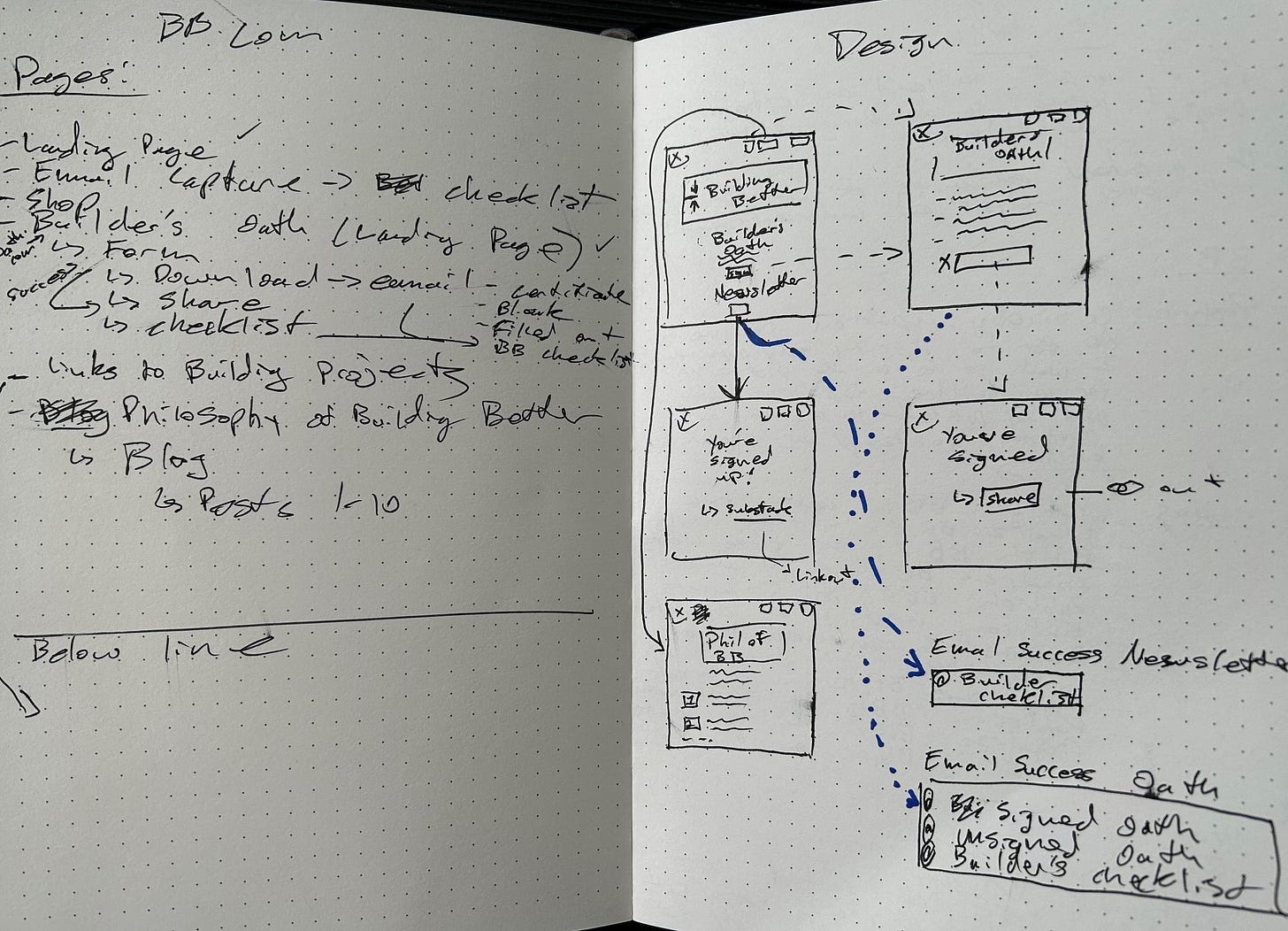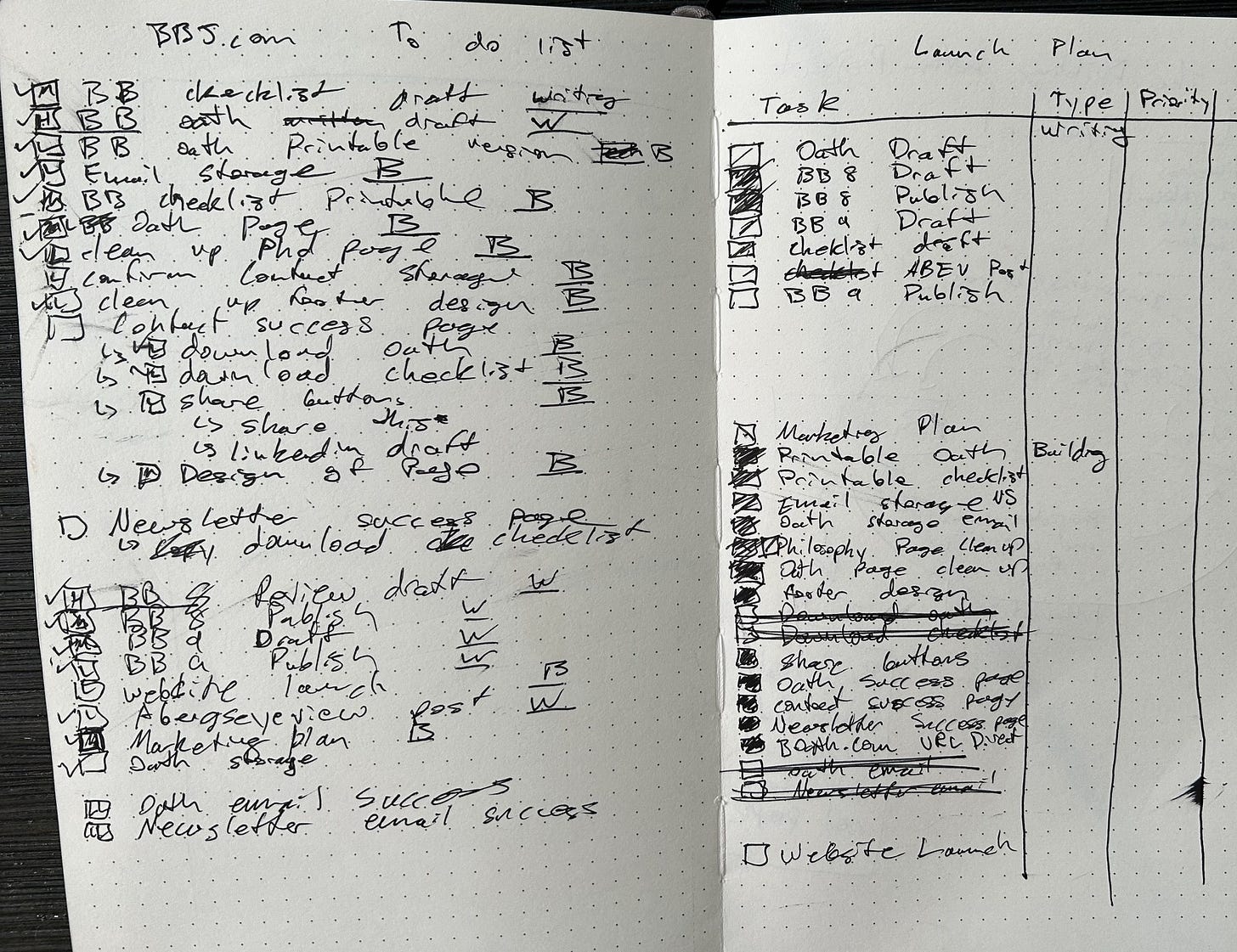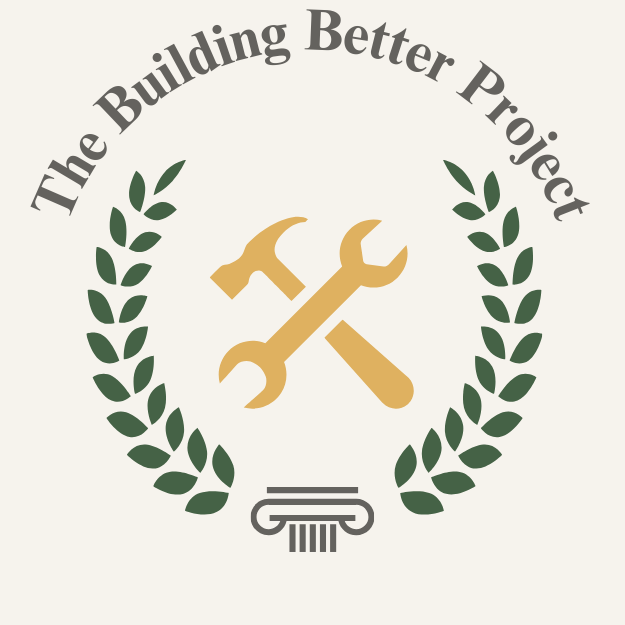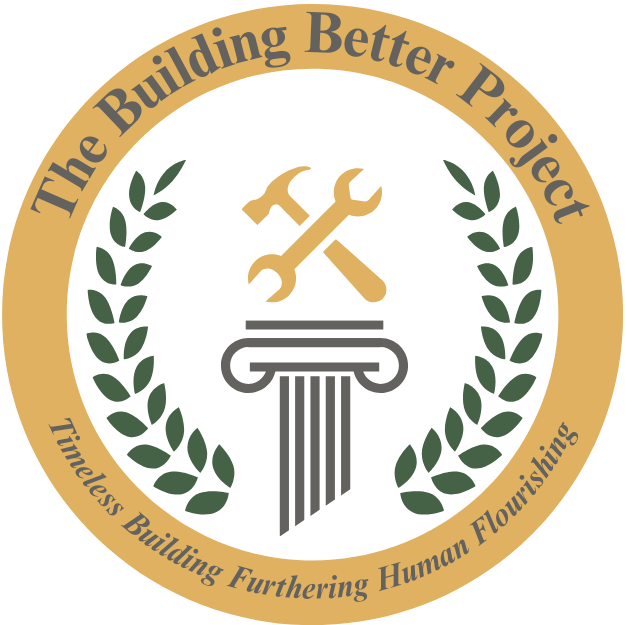Better Built: The Building Better Project
How disillusionment with VC and being bored at the airport led me to reimagine what it means to build
The History of The Building Better Project
The story of my career is that I have always had a strong sense that I am meant to build, but not really knowing what that means or knowing what I should be building. I have spent years trying to refine this concept of building and The Building Better Project is my latest attempt.
The Spark
My building inspiration was a defining conversation with my dad about the proudest moment of his career. He took over a small refrigeration company and grew it into a business that solved real problems for real people and provided over 1,000 employees with good, dignified work in the process.
I entered private equity hoping to follow in his footsteps, only to realize his hands-on, values-driven approach was rare. Most firms prioritized volume, cost-cutting, and financial engineering over real stewardship.
After a couple of years, I realized that private equity wasn’t for me. My hypothesis was that I could still scratch this itch to build by simply investing earlier. This belief led me into venture capital, where I immersed myself in the world of tech and startups. Eventually, I landed a job on the investment team of a venture studio in Columbus, Ohio. My hope was that at a venture studio, I would get to be more hands on and participate in building companies that could provide people with good, dignified work just like my dad.
It didn’t quite turn out that way.
Disillusionment with Venture Capital
What I thought would be a venture firm focused on hands-on company building turned out to be a nonprofit, state-funded organization using investment as just one tool to support the startup ecosystem in Ohio. The structure bred incentives that felt out of sync with what I believed venture capital should be: a principled craft, discerning the future and backing the overlooked builders shaping it.
Instead, I had a front row seat to an industry chasing trends and paper returns. Startups raised on hype, not substance, hoping to find a real company before the money ran out. The goal wasn’t to solve real problems for real people. It was to raise the next round. Companies were incentivized to “go big or go home” with the occasional wild success leaving a trail of the corpses of once promising companies in its wake.
Amid the noise, I noticed the best builders weren’t chasing trends. What they were building was rooted in their own lived experience. They knew their industries intimately. Many were solving real problems they had personally experienced. They weren’t media darlings or Ivy League dropouts. The entrepreneurs who were building “the right way” were often older, less flashy, and quietly motivated by a simple truth: “If I don’t fix this, no one else will.”
In many ways, venture was a great fit for me. I loved many aspects of the day to day work and my natural strengths mapped well onto what made a successful VC, but over time the feeling that it wasn’t the right fit gnawed more and more at me. Yes, I was interacting with “builders”, but I sure wasn’t building anything myself.
That gnawing disconnect led me to decide to pursue my MBA at Wharton. This had always been a lifelong goal and my hope was to leverage my experience in venture as a way to transition onto the “building” side of the tech world. Wharton was a very transformative experience for me. I took classes on everything from Influence and Business Ethics to Entrepreneurship and Behavioral Economics. Took a business idea from class all the way to the point where I was pitching to VCs. I had an internship at a fintech startup and got to see the highs and lows of early startup life. I got access to an executive coach and led a discussion group on purpose and meaning. I wrote more about my takeaways from the experience here, but the value I got from the experience was not what I expected. Instead of launching my high flying startup, I found myself prioritizing a path of more stable, sustainable building that opted out of the “pie eating contest” of chasing status. I joined Capital One as a product manager, not to make headlines, but to hone my craft. I stopped trying to be someone who builds something impressive, and started focusing on becoming someone who builds well.
Someone who builds real things for real people.
The Builder Identity
Post graduation, I spent a lot of time learning how software was built and the day to day responsibilities of being a product manager, but it felt like something was missing. I wasn’t really getting to flex my more entrepreneurial muscles. I tried starting a blog to write about entrepreneurship, but the effort felt disingenuous. How could I write about entrepreneurship without actually practicing what I preached?
Around this time, my wife got pregnant and I paused working on side projects to focus on the transition to fatherhood. During a getaway before the baby came, (during a couples massage of all things) the pieces in my head suddenly clicked into place. I realized that writing and building weren’t separate efforts, but two sides of the same coin for me. There was no writing or building.
It was all building.
I needed to write in order to clarify my philosophy on how to build and in order to properly think through my building efforts. I needed to build in order to be able to write about building in a genuine way. I wasn’t (yet) an entrepreneur and it felt disingenuous for me to write about entrepreneurship, but I WAS a builder and I could write about that.
Discovery the Timeless Way
During the first six months of my son’s life, I tried (struggled) to give myself the time and space to just focus on him and the transition to parenthood. I wasn’t doing much building, but I couldn’t stop thinking about it. The next revelation I experienced was on a work trip shortly after returning from my parental leave. I was waiting at the airport and needed something new to listen to. Scrolling through my audiobook library, I decided to try The Timeless Way of Building by Christopher Alexander, a book I’d impulsively bought years earlier but never listened to.
Within minutes, I was floored. This was the missing piece I had been searching for.
The Timeless Way of Building provided a roadmap to draw all of these separate strands together. It provided a framework through which I could search for the way things should be done. Alexander wasn’t interested in following the latest architecture trends. He wrote about building in harmony with the timeless truths that shape our world. Truths that have forever drawn people towards building in consistent and unifying ways. Truths that allowed people from across ages and cultures to build places that continue to shine with an internal light and a sense of airy comfort that can’t help but leave an indelible mark on anyone who visits.
In the Timeless Way of Building, I saw echoes of the kind of builder I wanted to be. A builder that didn’t pursue the latest trends, but one who solved real problems for real people. The most shocking part of the Timeless Way was that it was not some secret technique hidden from the world, but simply a process to help builders return to the tried and true methodologies of the past. It helped people re-learn what it was like to build for other flesh and blood human beings instead of trying to conform their efforts to align with preconceived notions of what “sophisticated” architecture should look like.
For perhaps the first time in my life, I wasn’t searching for a path. I had finally stumbled upon it almost by accident. I finally had a direction, now I just needed a plan for how to pursue it.
Developing the Philosophy
On my son’s six-month birthday, I went to a coffee shop and started planning out how I would tackle this project. I was guided by the question: “why is there a Hippocratic oath for doctors and not software engineers?” It was easy to see the importance of an oath like this in the world of medicine, but shouldn’t there be a similar ethical standard for tech given its impact on all of our lives? I imagined a modern Hippocratic Oath, not just for technologists, but for builders regardless of domain. This image became the central organizing principle behind my new building project.
My first step was figuring out what needed to go within this Oath. I started by drafting what would eventually become the Builders Oath, then worked backward to identify the foundational concepts needed to support it. It quickly became clear that there were eight pillars required for a coherent and compelling commitment to higher ethical standards for builders.
With my plan outlined, I began to write.
I drafted the introduction post and the first two “chapters” of my philosophy of building better before sharing them with close family and friends for their feedback. I wanted to get a sense of whether this idea would resonate with the sort of people I wanted it to resonate with. I got a lot of varied feedback, but the clear takeaway was that I was gesturing at something real, a missing piece in the discourse. At the very least, I was asking the right questions.
Armed with this initial validation, I outlined the remaining chapters and began writing more . I knew I had the first three posts in my back pocket, but I wanted to build up a bit of a backlog of posts so that I could really hit the ground running. I published my first post around Thanksgiving and set about trying to build a regular release schedule. Initially, I was always working a post ahead of my publishing schedule, but as life got in the way I steadily moved towards more of a bi-weekly cadence. This worked well and largely was the pattern I followed throughout the rest of my publishing the Philosophy of Building Better. As I approached the finish line, I began to devote more and more of my time to building the rest of the project.
Building The Building Better Project
I knew I wanted The Building Better Project to be more than just a series of blog posts. The end of my writing was building towards a Builder’s Oath and I needed a structure that allowed people to interact with it. I needed a website.
I started with pen and paper, sketching wireframes and mapping how each page would interact.

The essentials I needed were a landing page, a place for the Oath, a blog archive, contact form, and a few success screens. I didn’t build a technical document or a beautifully designed Figma. All you need is a pen and paper to begin making the unseen world seen.
I considered tools such as Carrd (strongly recommended for landing pages/product testing) and Wordpress (the gold standard but overwhelming for a lay designer like me) but ultimately chose Squarespace. I’d used it before for my personal blog and didn’t need anything more complex. I also had already purchased the domains. I used Canva to design the logos, banners, and social graphics. It’s very user friendly and has a ton of basic design building blocks that are a huge help for getting started.
As I approached launch, I began stripping away nonessentials. For example, I originally wanted users to receive a signed copy of the Oath by email. After spending way too long trying to figure out how I could enable this, I opted for a simple redirect to an unlisted download page. It wasn’t the absolute ideal experience, but it allowed signers to download hard copies of the Oath and it was straightforward to implement.

Throughout the whole building process I tried not to let the perfect become the enemy of the good. I got the website to the point where I was proud of it and decided that would have to be good enough. The Philosophy of Building Better argues that we should always aim for the objectively best solution given a certain context, but that context should include consideration for the time, effort, and other sacrifices needed to make that solution into a reality. If I had infinite time and resources I could’ve made the website a lot better with other cool features. In my case, the best version of TheBuildingBetterProject.com wasn’t perfectly polished. It was the version of the website that served its purpose and worked within my constraints while still being something that I was proud of sharing.
Publishing and Promotion
You may have noticed I haven’t said much about marketing or social media. That’s intentional. It’s not where I want to focus most of my energy. In the past, I tried to be super online and posting all the time. This may have increased my reach, but it never felt genuine. It also was a nagging pull away from the embodied present, a place I am trying to spend more and more time in.
Instead, I try to take an 80/20 approach. I share across a few key channels, using Buffer to schedule posts for optimal times (I’ve done some brief research on this for each channel, but Buffer also makes suggestions automatically). That is about the extent of my growth strategy. I’m sure there are more optimal approaches, but this is a side-project built on whatever hours I have left after my family, job, and health get my first fruits and I don’t want to spend any more of it than I need to on self-promotion. If anyone has any simple, genuine, not-icky ways they use to generate organic growth I’d definitely be curious to learn more.
With everything finally ready, I published the culminating post of the project. I subsequently reached out personally to folks in my network I thought may find it interesting/meaningful.
Evaluating Myself Against the Building Better Checklist
With all my acts of building, I want to true back to the Philosophy of Building Better and hold myself accountable via the Building Better Checklist.
Have I admitted that I am a builder and I have a responsibility to build to the best of my ability?
Yes! The story outlined above was my journey to realizing that I am a builder. And so are you!
Am I building with the flourishing of the end user in mind?
Definitely. The Building Better Project represents some of the most important truths and ideals in my life and a big motivation behind sharing them is my belief that exposing others to these concepts will be additive to their flourishing.
Have I considered the physical context of what I am building?
To the degree possible! As outlined above, I didn’t try to make the visual design perfect, but I did put in thought and effort to try to get it to the point that I could feel proud of it. My other blog was made on Squarespace which offered a lot of customizability, but for this project I knew Substack would be sufficient and would help take some of the distribution burden off of my shoulders.
Have I considered the personal context of what I am building?
I tried to! I gathered feedback from friends and family from a variety of different backgrounds in an attempt to ensure that my writing would resonate with the sort of people I wanted it to while remaining accessible. I haven’t really take into account people tangential to my readers, but if my writing helps my readers better themselves and their own building efforts I can only imagine that would have a positive ripple effect to others in their orbit.
Have I considered the societal context of what I am building?
Definitely. Similar to the item about building with the flourishing of the end user in mind, I think our world NEEDS to be re-introduced to so many of the ideas that we have discarded. I believe that our modern society has become unmoored from the values, ideas, and conduct that was the foundation our world was built upon. The Building Better Project is my attempt to make these ideas relevant and accessible to a modern audience. I don’t expect The Philosophy of Building Better to be a panacea to all the woes of our society, but if even a small number of people begin to ask themselves more questions about the impact of what they are building, I think our world will genuinely be better for it.
Have I considered the temporal context of what I am building?
I will give myself a passing grade on this, but there is definitely room for improvement here. I think I have done a good job of suffusing my writing with timeless wisdom, but I still feel like I am abjectly unversed in the great books and ideas of human civilization. I am making a lot of progress through my classics book club and my own personal reading, but I still feel like I am woefully behind where I would like to be.
Does what I am building resolve the competing forces of its context to the best of my ability?
Yes. I have genuinely tried to bring something forth in the world that draws together the ideas of building, ethics, technology, philosophy, design, architecture, and more. It is admittedly a tall task that I am sure I have fallen short of plenty, but I have always, and will always, do the best I am able.
Do I genuinely believe that what I am building is the objectively best approach given the competing forces of its context?
Yes, I think so. This feels like the right path for The Building Better Project for the moment. I still feel like there is more foundation left to build through my writing, but I have lots of ideas about how it can grow and evolve into the future.
Does what I am building avoid taking advantage of people's worst impulses?
Yes. I believe the Philosophy of Building Better is a scaffolding for the quiet voice of conscious in people’s heads. This is in a context where so much of the content around building, technology, and entrepreneurship is purpose built for algorithmic FOMO induction. If anything, maybe there is an argument I am going too far to try to avoid following the crowd and in doing so I am missing out on the opportunity to make my work more accessible and to have a broader reach. Something to contemplate.
Have I thought of my user/customer as a friend and sought to build in a way that seeks their good as an end unto itself?
Yes! A friend once asked me who the target audience of The Building Better Project was and I told him “2019 Erik”. Admittedly this is slightly different than seeking the good for a friend, but I think writing to try to communicate the concepts and ideas I wish I had been exposed to earlier plays a similar role.
Have I avoided ethically compromising in any of my building decisions?
I believe so. To the degree I have included ideas or content that are not my own I have always tried to give credit where it is due. All of the graphics in my posts either have an open source license or are things I have created myself. I probably could do a better job of attributing the art I use on TheBuildingBetterProject.com. It isn’t required by its usage license but that would be most in line with the spirit of this item on the Building Better Checklist.
Have I done what I can to safeguard my building projects against the burdens of time?
To the degree possible. Part of the goal of Building Better has been to write evergreen content as opposed to content overly focused on the latest news or trends. My hope with this approach is that my posts can hold up years or even decades down the road. I think there is some small risk to the longevity of my posts caused by having them hosted on Substack, but I have tried to safeguard against that by replicating all of the chapters of The Philosophy of Building Better on my own website (which admittedly is hosted by Squarespace but you have to stop somewhere).
Have I been vigilant for opportunities to repair the context surrounding my buildings through my building efforts?
Yes, but more to come. In some way the entire purpose of The Building Better Project is an attempt at repair. Admittedly, the bulk of my posts so far have centered mostly on the theoretical, but going forward that mix will tip much more towards the practical. Through these posts I hope to make the Philosophy of Building Better much more tangible, actionable, and to actually contribute to the repair of the context surrounding me and my readers.
Have I committed myself to a higher standard for ethical building by signing The Builder's Oath?
YES! And you can join me by signing The Builder’s Oath here!
Conclusion: What Comes Next
There are definitely things I'd have done differently with the benefits of hindsight, but overall I am extremely proud of what I built and how I built it. The Building Better project bring together some of the most influential wisdom I’ve encountered in a way that I hope is approachable whether you are a product manager, architect, or someone trying to simply build a better life. Just as importantly, my writing efforts have helped me to get into a better habit of committing my time and energy to working on side projects. Building this habit of working on what I believe to be my life’s great work is definitely still a work in progress, but I am building more momentum everyday.
This was the first in a new series I am calling Better Built. I hope this glimpse behind the scenes of my building process and how I applied the Philosophy of Building Better has been helpful and informative. A philosophy is only as good as its ability to be put into practice and my hope with the Better Built series is to show you exactly the tools, tactics, and processes that I use to approach my building.
I’ve got more experiments for potential post formats on the way. If something resonates (or doesn’t), I’d love to hear your feedback. Your thoughts will help shape where we go next. Thanks, as always, for being part of the journey.
Let’s Build Better,
Erik
If you found this post compelling, consider joining me in signing The Builder’s Oath and committing to a higher standard of building conduct.
To learn more about the Philosophy of Building Better, a great place to start is my post on The Builder’s Oath which sums up all of the core tenets of the Philosophy. If you would like to go back through each post, you can also find them stored on TheBuildingBetterProject.com.



